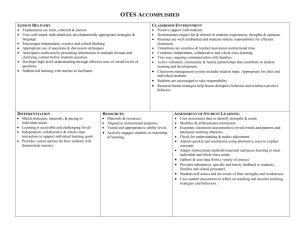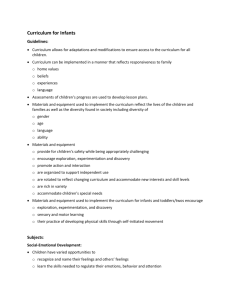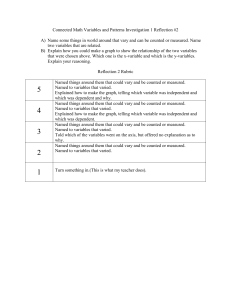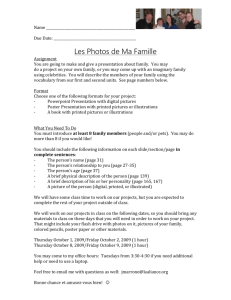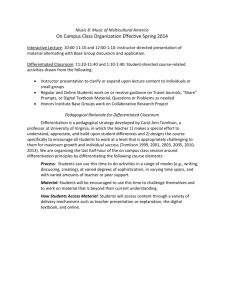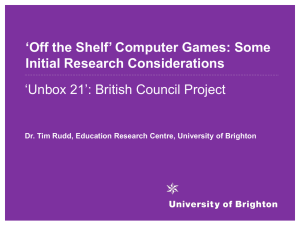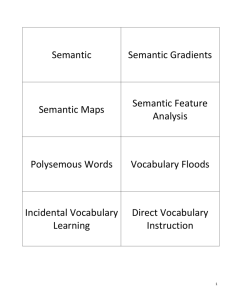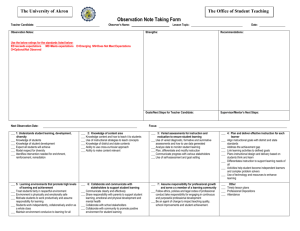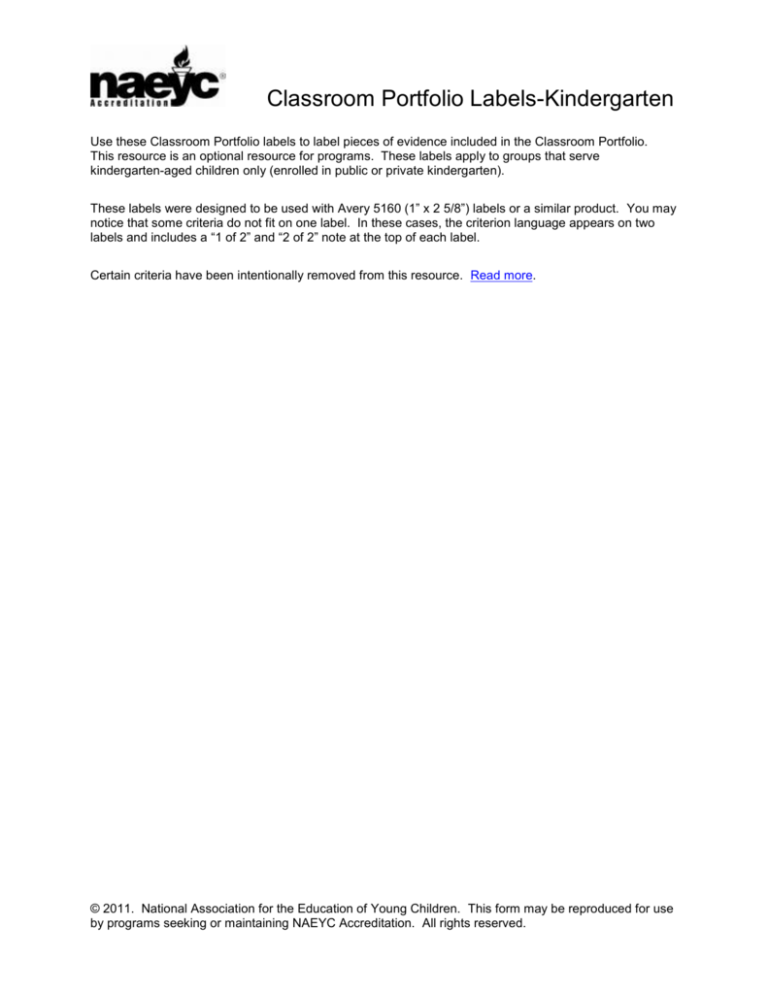
Classroom Portfolio Labels-Kindergarten
Use these Classroom Portfolio labels to label pieces of evidence included in the Classroom Portfolio.
This resource is an optional resource for programs. These labels apply to groups that serve
kindergarten-aged children only (enrolled in public or private kindergarten).
These labels were designed to be used with Avery 5160 (1” x 2 5/8”) labels or a similar product. You may
notice that some criteria do not fit on one label. In these cases, the criterion language appears on two
labels and includes a “1 of 2” and “2 of 2” note at the top of each label.
Certain criteria have been intentionally removed from this resource. Read more.
© 2011. National Association for the Education of Young Children. This form may be reproduced for use
by programs seeking or maintaining NAEYC Accreditation. All rights reserved.
Standard 1: Relationships
1.A.03.a Teachers communicate with
family members on an ongoing basis to a.
learn about children’s individual needs.
Topic Area 1.C. Helping Children
Make Friends
1.C.03.c Teaching staff support children
as they practice social skills and build
friendships by helping them c. enhance play
Topic Area 1.A. Building Positive
Relationships Among Teachers and
Families
1.D.01.e Teaching staff counter potential
families, establishing and maintaining
regular, ongoing, two-way communication.
1.A.03.b Teachers communicate with
1.A.05 Teachers share information with
family members on an ongoing basis to
b. ensure a smooth transition between home
and program.
families about classroom rules, expectations
and routines not only at enrollment but also
as needed throughout the year.
1.C.03.a Teaching staff support children
1.C.03.b Teaching staff support children
as they practice social skills and build
friendships by helping them a. enter into
[play]
as they practice social skills and build
friendships by helping them b. sustain
[play]
Topic Area 1.D. Creating a
Predictable, Consistent, and
Harmonious Classroom
1.D.01.a Teaching staff counter potential
bias and discrimination by a. treating all
children with equal respect and
consideration,
1.D.01.d Teaching staff counter potential
1.D.01.b Teaching staff counter potential
bias and discrimination by b. initiating
activities and discussions that build positive
self-identity and teach the valuing of
differences,
1.A.01 Teachers work in partnership with
1.D.01.c Teaching staff counter potential
bias and discrimination by c. intervening
when children tease or reject others,
1.D.02.a Teachers provide children
bias and discrimination by d. providing
models and visual images of adult roles,
differing abilities, and ethnic or cultural
backgrounds that counter stereotypical
limitations,
1.D.02.b Teachers provide children
opportunities to develop the classroom
community through participation in
decision making about classroom a. rules
opportunities to develop the classroom
community through participation in
decision making about classroom b. plans,
and
1.D.04.a Teachers help children talk about
1.D.04.b Teachers help children talk
a. their own [emotions]
about b. others’ emotions.
for children to c. explore a wide range of
feelings and the different ways that those
feelings can be expressed.
Standard 2: Curriculum
Topic Area 2.A. Curriculum:
Essential Characteristics
2.A.07.a The curriculum guides the
2.A.07.b The curriculum guides the
2.A.07.c The curriculum guides the
development of a daily schedule that is
predictable yet flexible and responsive to
individual needs of the children. The
schedule a. provides time and support for
transitions.
development of a daily schedule that is
predictable yet flexible and responsive to
individual needs of the children. The
schedule b. includes both indoor and
outdoor experiences.
development of a daily schedule that is
predictable yet flexible & responsive to
individual needs of the children. The
schedule c. is responsive to a child’s need to
rest or be active.
2.A.08.a Materials and equipment used to
2.A.08.b Materials and equipment used to
2.A.08.c Materials and equipment used to
implement the curriculum reflect the lives
of the children & families as well as the
diversity found in society, including
a. gender,
implement the curriculum reflect the lives
of the children & families as well as the
diversity found in society, including
b. age,
implement the curriculum reflect the lives
of the children and families as well as the
diversity found in society, including
c. language, and
bias and discrimination by e. avoiding
stereotypes in language references.
1.D.02.c Teachers provide children
opportunities to develop the classroom
community through participation in
decision making about classroom c.
activities.
1.D.04.c [Teachers] provide opportunities
2.A.08.d Materials and equipment used to
implement the curriculum reflect the lives
of the children and families as well as the
diversity found in society, including
d. abilities.
2.A.08.e Materials and equipment e.
2.A.08.g Materials and equipment
2.A.08.h Materials and equipment h. are
g. promote action and interaction.
organized to support independent use.
2.A.08.j Materials and equipment
2.A.08.k Materials and equipment
j. are rich in variety.
k. accommodate children’s special needs.
to incorporate content, concepts, and
activities that foster a. social
[development],
2.A.10.b The curriculum guides teachers
2.A.10.c The curriculum guides teachers
2.A.10.d The curriculum guides teachers
to incorporate content, concepts, and
activities that foster b. emotional
[development],
to incorporate content, concepts, and
activities that foster c. physical
[development],
to incorporate content, concepts, and
activities that foster d. language
[development], and
provide for children’s safety while being
appropriately challenging.
2.A.08.f Materials and equipment
f. encourage exploration, experimentation,
and discovery.
2.A.08.i Materials and equipment i. are
rotated to reflect changing curriculum and
accommodate new interests and skill levels.
2.A.10.a The curriculum guides teachers
2.A.10.e The curriculum guides teachers
2.A.10.f The curriculum guides teachers to
2.A.11.a The schedule a. provides
to incorporate content, concepts, and
activities that foster e. cognitive
development and
incorporate content, concepts, and activities that
f. integrate key areas of content including
literacy, mathematics, science, technology,
creative expression and the arts, health and
safety, and social studies.
2.A.11.b The schedule [incorporates time
2.A.11.c The schedule [incorporates time
2.A.11.d The schedule [incorporates time
for:] b. play,
for:] c. creative expression,
for:] d. large-group [activity],
2.A.11.e The schedule [incorporates time
2.A.11.f The schedule [incorporates time
for:] e. small-group [activity], and
for:] f. child-initiated activity.
children learning opportunities, experiences,
and projects that extend over the course of
several days [and incorporates time for:]
2.A.12 The curriculum guides teachers to
Topic Area 2.C. Curriculum Area of
Development: Physical
Development
2.C.04.b Children have varied
2.C.03 Children are provided varied
opportunities and materials that support
fine-motor development.
2.C.04.c Children have varied
opportunities and are provided equipment to
engage in large motor experiences that
b. enhance sensory-motor integration.
opportunities and are provided equipment to
engage in large motor experiences that
c. develop controlled movement (balance,
strength, coordination).
2.C.04.e Children have varied
2.C.04.f Children have varied
opportunities and are provided equipment to
engage in large motor experiences that
e. range from familiar to new and
challenging.
opportunities and are provided equipment to
engage in large motor experiences that
f. help them learn physical games with rules
and structure.
plan for children's engagement in play
(including dramatic play and blocks) that is
integrated into classroom topics of study.
2.C.04.a Children have varied
opportunities and are provided equipment to
engage in large motor experiences that
a. stimulate a variety of skills.
2.C.04.d Children have varied
opportunities and are provided equipment to
engage in large motor experiences that
d. enable children with varying abilities to
have large-motor experiences similar to
those of their peers.
Topic Area 2.D. Curriculum: Areas
of Development: Language
Development
2.D.02 Children are provided
opportunities to experience oral and written
communication in a language their family
uses or understands.
2.D.04.a Children have varied
2.D.04.b Children have varied
opportunities to develop vocabulary through
a. conversations,
opportunities to develop vocabulary through
b. experiences,
2.D.04.c Children have varied
2.D.04.d Children have varied
opportunities to develop vocabulary through
c. field trips, and
opportunities to develop vocabulary through
d. books.
2.D.06.b Children have varied
Topic Area 2.E. Curriculum
Content Area for Cognitive
Development: Early Literacy
opportunities and materials that encourage
them to have discussions to solve problems
that are [both] b. related to the physical
world.
2.D.06.a Children have varied
opportunities and materials that encourage
them to have discussions to solve problems
that are [both] a. interpersonal and
2.E.03.a (1 of 2) Children have
opportunities to become familiar with print.
They are actively involved in making sense
of print, and they have opportunities to become familiar with, recognize, and use print
that is accessible throughout the classroom:
2.E.03.b (1 of 2) Children have
2.E.03.a (2 of 2) a. Items belonging to a
child are labeled with his or her name
opportunities to become familiar with print.
They are actively involved in making sense
of print, and they have opportunities to become familiar with, recognize, and use print
that is accessible throughout the classroom:
2.E.03.c (1 of 2) Children have
opportunities to become familiar with print.
They are actively involved in making sense
of print, and they have opportunities to become familiar with, recognize, and use print
that is accessible throughout the classroom:
2.E.03.b (2 of 2) b. Materials are
labeled.
2.E.03.d (1 of 2) Children have
2.E.03.c (2 of 2) c. Print is used to
describe some rules and routines.
opportunities to become familiar with print.
They are actively involved in making sense
of print, and they have opportunities to become familiar with, recognize, and use print
that is accessible throughout the classroom:
2.E.04.a Children have varied
2.E.03.d (2 of 2) d. Teaching staff help
children recognize print and connect it to
spoken words.
2.E.04.c Children have varied
opportunities to c. explore books on their
own and have places that are conducive to
the quiet enjoyment of books.
2.E.04.f Children have varied
opportunities to f. retell and reenact events
in storybooks.
2.E.04.i Children have varied
opportunities to i. identify the parts of
books and differentiate print from pictures.
2.E.05.c Children have multiple and
varied opportunities to write: c. Children
have daily opportunities to write or dictate
their ideas.
opportunities to a. be read books in an
engaging manner in group or individualized
settings at least twice a day in full-day
programs and at least once daily in half-day
programs.
2.E.04.b Children have varied
opportunities to b. be read to regularly in
individualized ways including one-to-one or
in small groups of two to six children
2.E.04.d Children have varied
opportunities to d. have access to various
types of books, including storybooks,
factual books, books with rhymes, alphabet
books, and wordless books.
2.E.04.g Children have varied
opportunities to g. engage in conversations
that help them understand the content of the
book.
2.E.04.e Children have varied
opportunities to e. be read the same book on
repeated occasions.
2.E.04.h Children have varied
opportunities to h. be assisted in linking
books to other aspects of the curriculum.
2.E.05.a Children have multiple and
2.E.05.b Children have multiple and
varied opportunities to write: a. Writing
materials and activities are readily available
in art, dramatic play, and other learning
centers.
varied opportunities to write: b. Various
types of writing are supported, including
scribbling, letter-like marks, and
developmental spelling.
2.E.05.d Children have multiple and
2.E.05.e Children are given the support
varied opportunities to write: d. Children
are provided needed assistance in writing
the words and messages they are trying to
communicate.
they need to write on their own, including
access to the e. alphabet [both of] which are
made available at eye level or on laminated
cards.
2.E.05.f Children are given the support
they need to write on their own, including
access to f. printed words about topics of
current interest, [both of] which are made
available at eye level or on laminated cards.
2.E.05.g g. Children see teaching staff
model functional use of writing and are
helped to discuss the many ways writing is
used in daily life.
2.E.07.a Children are given opportunities
2.E.09.a Kindergartners have varied
2.E.09.b Kindergartners have varied
to b. write letters.
opportunities to learn to read familiar
a. words,
opportunities to learn to read familiar
b. sentences, and
2.E.09.c Kindergartners have varied
2.E.10.a Kindergartners are encouraged to
2.E.10.b Kindergartners are encouraged
opportunities to learn to read familiar
c. simple books.
identify phonemes in words through varied
activities, including a. writing and
to identify phonemes in words through
varied activities, including b. games.
2.F.02 Children are provided varied
2.E.11 Each kindergartner is encouraged
Topic Area 2.F. Curriculum Content
Area for Cognitive Development:
Early Mathematics
2.E.07.b Children are given opportunities
to write independently each day.
to a. recognize [letters] and
opportunities and materials to build
understanding of numbers, number names,
and their relationship to object quantities
and to symbols.
2.F.06 Children are provided varied
2.F.03 Children are provided varied
opportunities and materials to understand
basic concepts of geometry by, for example,
naming and recognizing two- and threedimensional shapes and recognizing how
figures are composed of different shapes.
2.F.07 Children are provided varied
opportunities and materials to categorize by
one or two attributes such as shape, size,
and color.
2.F.08 Children are provided varied
2.F.09.a Kindergartners are provided
2.F.09.b Kindergartners are provided
opportunities and materials that help them
recognize and name repeating patterns.
varied opportunities and materials to use a.
standard [units of measurement] and
opportunities and materials to use b.
nonstandard units of measure and to
2.F.09.c Kindergartners are provided
2.F.10.a Kindergartners are provided
varied opportunities and materials to c.
assign numerical values to measurements.
varied opportunities and materials to
a. create [repeating and growing patterns],
2.F.10.c Kindergartners are provided
varied opportunities and materials to
c. discuss [repeating and growing patterns],
and
2.F.12 Kindergartners are provided varied
opportunities and materials to use numerical
symbols and to explore operations on
quantities, such as adding, taking away, and
dividing into equal and unequal subsets.
2.G.02.a Children are provided varied
opportunities and materials to learn key content
and principles of science such as a. the difference between living and nonliving things (e.g.
plants versus rocks) and life cycles of various
organisms (e.g., plants, butterflies, humans).
2.F.10.d Kindergartners are provided
varied opportunities and materials to d.
extend repeating and growing patterns.
2.F.13 Kindergartners are provided varied
opportunities and materials that introduce
them to conventional tools such as a
calendar and a clock for understanding time.
opportunities to build an understanding of
time in the context of their lives, schedules,
and routines.
2.F.10.b Kindergartners are provided
varied opportunities and materials to
b. represent [repeating and growing
patterns],
2.F.11 Kindergartners are provided varied
opportunities and materials that encourage
them to use written mathematical
representations in everyday experiences.
Topic Area 2.G. Curriculum
Content Area for Cognitive
Development: Science
2.G.02.b Children are provided varied
opportunities and materials to learn key
content and principles of science such as b.
earth and sky (e.g., seasons; weather;
geologic features; light and shadow; sun,
moon, and stars).
2.G.02.c (1 of 2) Children are provided
varied opportunities and materials to learn
key content and principles of science such
as
2.G.02.c (2 of 2) c. structure and
property of matter (e.g., characteristics that
include concepts like hard and soft, floating
and sinking)and behavior of materials (e.g.,
transformation of liquids and solids by
dissolving or melting).
2.G.05.a Children are provided varied
opportunities and materials to a. collect data
[and to]
2.G.08 Children are provided varied
opportunities and materials that help them
learn and use scientific terminology and
vocabulary associated with the content
areas.
2.G.03 Children are provided varied
opportunities and materials that encourage
them to use the five senses to observe,
explore, and experiment with scientific
phenomena.
2.G.04 Children are provided varied
2.G.05.b Children are provided varied
2.G.06 Children are provided varied
opportunities and materials to b. represent
and document their findings (e.g., through
drawing or graphing).
opportunities and materials that encourage
them to think, question, and reason about
observed and inferred phenomena.
Topic Area 2.H. Curriculum
Content Area for Cognitive
Development: Technology
2.H.03.a Technology is used to a. extend
opportunities to use simple tools to observe
objects and scientific phenomena.
learning within the classroom.
Topic Area 2.J. Curriculum Content
Area for Cognitive Development:
Creative Expression and the Arts
2.J.01.a Children are provided varied
2.J.01.b Children are provided varied
2.J.01.c Children are provided varied
2.J.01.d Children are provided varied
opportunities to gain an appreciation of
b. music [in ways that reflect cultural
diversity],
opportunities to gain an appreciation of
c. drama [in ways that reflect cultural
diversity] , [and]
opportunities to gain an appreciation of
d. dance in ways that reflect cultural
diversity,
2.J.04.a Children are provided varied
2.J.04.b Children are provided varied
2.J.04.c Children are provided varied
opportunities to learn new concepts and
vocabulary related to a. art,
opportunities to learn new concepts and
vocabulary related to b. music,
opportunities to learn new concepts and
vocabulary related to c. drama, and
2.H.03.b Technology is used to b.
integrate and enrich the curriculum.
2.J.05 Children are provided varied
2.J.04.d Children are provided varied
opportunities to gain an appreciation of
a. art [in ways that reflect cultural
diversity],
2.J.06.a Children are provided many and
opportunities to learn new concepts and
vocabulary related to d. dance.
opportunities to develop and widen their
repertoire of skills that support artistic
expression (e.g., cutting, gluing, and caring
for tools).
2.J.06.b Children are provided many and
2.J.06.c Children are provided many and
2.J.06.d Children are provided many and
varied open-ended opportunities and
materials to express themselves creatively
through b. drama,
varied open-ended opportunities and
materials to express themselves creatively
through c. dance and
varied open-ended opportunities and
materials to express themselves creatively
through d. two- and three-dimensional art.
2.J.07.a Children have opportunities to
2.J.07.b Children have opportunities to
respond to the art of a. other children and
respond to the art of b adults.
Topic Area 2.K. Curriculum
Content Area for Cognitive
Development: Health and Safety
2.K.01 Children are provided varied
opportunities and materials that encourage
good health practices such as serving and
feeding themselves, rest, good nutrition,
exercise, hand washing, and tooth brushing.
varied open-ended opportunities and
materials to express themselves creatively
through a. music,
2.K.02.a Children are provided varied
2.K.02.b Children are provided varied
opportunities and materials to help them
learn about nutrition, including a.
identifying sources of food and
opportunities and materials to help them
learn about nutrition, including b.
recognizing [healthy foods],
2.K.02.c Children are provided varied
2.K.02.d Children are provided varied
2.K.02.e Children are provided varied
opportunities and materials to help them
learn about nutrition, including c. preparing
[healthy foods],
opportunities and materials to help them
learn about nutrition, including d. eating
[healthy foods], and
opportunities and materials to help them
learn about nutrition, including e. valuing
healthy foods.
2.K.03.a Children are provided varied
2.K.03.b Children are provided varied
opportunities and materials that increase
their awareness of safety rules in their a.
classroom,
opportunities and materials that increase
their awareness of safety rules in their b.
home, and community.
Topic Area 2.L. Curriculum Content
Area for Cognitive Development:
Social Studies
2.L.01.a Children are provided varied
learning opportunities that foster positive
identity and an emerging sense of a. self
and
2.L.01.b Children are provided varied
2.L.02 Children are offered opportunities
learning opportunities that foster positive
identity and an emerging sense of b. others.
to become a part of the classroom
community so that each child feels accepted
and gains a sense of belonging.
2.L.03.a Children are provided varied
2.L.03.b Children are provided varied
2.L.03.c Children are provided varied
opportunities and materials to build their
understanding of diversity in a. culture [in
non-stereotypical ways],
opportunities and materials to build their
understanding of diversity in b. family
structure [in non-stereotypical ways],
opportunities and materials to build their
understanding of diversity in c. ability [in
non-stereotypical ways],
2.L.03.d Children are provided varied
2.L.03.e Children are provided varied
2.L.03.f Children are provided varied
opportunities and materials to build their
understanding of diversity in d. language
[in non-stereotypical ways],
opportunities and materials to build their
understanding of diversity in e. age [in nonstereotypical ways], [and]
opportunities and materials to build their
understanding of diversity in f. gender
in non-stereotypical ways.
2.L.05 Children are provided varied
2.L.06.a Children have varied
opportunities and materials to learn about
the community in which they live.
opportunities to engage in discussions about
a. fairness,
2.L.06.b Children have varied
2.L.06.c Children have varied
2.L.06.d Children have varied
opportunities to engage in discussions about
b. friendship,
opportunities to engage in discussions about
c. responsibility,
opportunities to engage in discussions about
d. authority, and
2.L.04 Children are provided
opportunities and materials to explore social
roles in the family and workplace through
play.
2.L.07 Children are provided varied
2.L.06.e Children have varied
opportunities to engage in discussions about
e. differences.
2.L.08.b Children are provided varied
opportunities and materials to learn how
people affect their environment in b.
negative (e.g., polluting) ways.
opportunities and materials to learn about
physical characteristics of their local
environment as a foundation for learning
geography.
2.L.10 Children are provided opportunities
and materials that build a foundation for
understanding economic concepts (e.g.,
playing restaurant, managing a store, and
identifying and exchanging money).
2.L.08.a Children are provided varied
opportunities and materials to learn how
people affect their environment in
a. positive (e.g., recycling) [ways] and
2.L.11 Kindergartners are provided
opportunities and materials that help them link
learning about their hometown, their state, the
United States and their country of origin to
previous learning, as a foundation for learning
geography, history, and social studies.
3.A.01 Teaching staff, program staff or both
Standard 3: Teaching
Topic Area 3.A. Designing
Enriched Learning Experiences
work as a team to implement daily teaching and
learning activities, including Individualized
Family Service Plans (IFSPs), Individualized
Education Programs (IEPs), and other individual
plans as needed.
3.A.06.b b. [Teachers] ensure that
3.A.06.a a. Teachers create classroom
displays that help children reflect on and
extend their learning.
3.A.07 Teaching staff and children work
together to arrange classroom materials in
predictable ways so children know where to
find things and where to put them away.
children’s recent works predominate in
classroom displays (e.g., art, emergent
writing, graphic representation, and threedimensional creations) and
3.A.06.c c. [Teachers ensure that] some
displays are at children’s eye level.
3.B.02.a Teaching staff create and
Topic Area 3.B. Creating Caring
Communities for Learning
maintain a setting in which children of
differing abilities can progress, with
guidance, toward increasing levels of: a.
autonomy,
3.B.02.bTeaching staff create and
3.B.02.c Teaching staff create and
maintain a setting in which children of
differing abilities can progress, with
guidance, toward increasing levels of: b.
responsibility, and
maintain a setting in which children of
differing abilities can progress, with
guidance, toward increasing levels of: c.
empathy.
3.B.11.b Teaching staff create a climate of
3.B.11.c Teaching staff create a climate of
mutual respect for children by being
interested in their b. experiences, and
mutual respect for children by being
interested in their c. products.
Topic Area 3.D. Using Time,
Grouping, and Routines to Achieve
Learning Goals
3.D.04 Teaching staff offer children
3.D.05.a Teachers plan for children to
3.D.05.b Teachers plan for children to
opportunities to interact with children of
various ages.
revisit experiences and materials over
periods of a. days,
revisit experiences and materials over
periods of b. weeks, and
3.D.05.c Teachers plan for children to
3.D.10.a Teachers organize time and
3.D.10.b Teachers organize time and
revisit experiences and materials over
periods of c. months.
space on a daily basis to allow children to
work or play a. individually and
space on a daily basis to allow children to
work or play b. in pairs,
3.D.10.d Teachers organize time and
3.D.11 Teachers create opportunities for
space on a daily basis to allow children to
work or play d. to engage as a whole group.
children to engage in group projects and to
learn from one another.
3.D.10.c Teachers organize time and
space on a daily basis to allow children to
work or play c. to come together in small
groups, and
3.B.11.a Teaching staff create a climate of
mutual respect for children by being
interested in their a. ideas,
3.E.01 Teaching staff reorganize the
Topic Area 3.E. Responding to
Children’s Interests and Needs
environment when necessary to help
children explore new concepts and topics,
sustain their activities, and extend their
learning.
3.E.02.b Teachers scaffold children’s
3.E.02.c Teachers scaffold children’s
learning by: b. intentionally arranging the
equipment, and
learning by: c. making themselves available
to children.
3.E.04 Teachers use their knowledge of
individual children to modify strategies and
materials to enhance children's learning.
3.E.08.a Teachers use their knowledge of
children’s a. social relationships [to tailor
learning opportunities for groups and
individuals],
3.E.02.a Teachers scaffold children’s
learning by: a. modifying the schedule.
3.E.03 Teachers use children's interest in
and curiosity about the world to engage
them with new content and developmental
skills.
3.E.08.b Teachers use their knowledge of
children’s b. interests [to tailor learning
opportunities for groups and individuals],
3.E.08.c Teachers use their knowledge of
children’s c. ideas [to tailor learning
opportunities for groups and individuals],
and
3.F.01 Teachers use curriculum in all
content and developmental areas as a
flexible framework for teaching and to
support the development of daily plans and
learning experiences.
Topic Area 3.G. Using
Instruction to Deepen Children’s
Understanding and Build Their
Skills and Knowledge
3.G.02.b Teachers use multiple sources
(including results of informal and formal
assessments as well as children’s initiations,
questions, interests, and misunderstandings)
to b. adapt curriculum and teaching to meet
children’s needs and interests.
3.G.02.e Teachers use multiple sources
(including results of informal and formal
assessments as well as children’s initiations,
questions, interests, and misunderstandings)
to e. support self-initiated learning.
3.E.08.d Teachers use their knowledge of
children’s d. skills to tailor learning
opportunities for groups and individuals.
Topic Area 3.F. Making Learning
Meaningful for All Children
3.F.02 Play is planned for each day.
3.F.06 Teachers offer children
opportunities to engage in classroom
experiences with members of their families.
3.G.02.a Teachers use multiple sources
3.G.01 Teachers have and use a variety of
teaching strategies that include a broad
range of approaches and responses.
(including results of informal and formal
assessments as well as children’s initiations,
questions, interests, and misunderstandings)
to a. identify what children have learned.
3.G.02.c Teachers use multiple sources
3.G.02.d Teachers use multiple sources
(including results of informal and formal
assessments as well as children’s initiations,
questions, interests, and misunderstandings)
to c. foster children’s curiosity.
(including results of informal and formal
assessments as well as children’s initiations,
questions, interests, and misunderstandings)
to d. extend children’s engagement.
3.G.03.a As children learn and acquire
3.G.03.b As children learn and acquire
new skills, teachers a. use their knowledge
of children’s abilities to fine-tune their
teaching support.
new skills, teachers b. adjust challenges as
children gain competence and
understanding.
3.G.09.a Teachers engage in collaborative
3.G.09.b Teachers engage in collaborative
inquiry with a. individual children and
inquiry with b. small groups of children.
3.G.12.a Teachers promote children’s
3.G.12.b Teachers promote children’s
engagement and learning by: a. responding
to their need for and interest in practicing
emerging skills, and
engagement and learning: b. by enhancing
and expanding activities that children
choose to engage in repeatedly.
3.G.08 Teachers help children identify and
use prior knowledge. They provide
experiences that extend and challenge
children's current understandings.
3.G.11 Teachers are able to determine the
different components of a task and break it
into meaningful and achievable parts.
3.G.13 Teachers promote children's
engagement and learning by guiding them
in acquiring specific skills and by explicitly
teaching those skills.
Topic Area 4.B. Using Appropriate
Assessment Methods
3.G.14 Teachers demonstrate their
knowledge of content and developmental
areas by creating experiences that engage
children in purposeful and meaningful
learning related to key curriculum concepts.
4.B.05.a Staff-developed assessment
4.B.05.b Staff-developed assessment
methods a. are aligned with curriculum
goals.
methods b. provide an accurate picture of
all children’s abilities and progress.
4.B.05.d Staff-developed assessment
4.B.05.c Staff-developed assessment
methods c. are appropriate and valid for
their stated purposes.
Standard 4: Assessment of
Child Progress
methods d. provide meaningful and stable
results for all learners, including Englishlanguage learners and children with special
needs.
4.B.05.e Staff-developed assessment
methods e. provide teachers with clear ideas
for curriculum development and daily
planning.
4.B.05.f Staff-developed assessment
methods f. are regularly reviewed to be
certain that they are providing the needed
information.
4.C.03 Teachers refer to curriculum goals
and developmental expectations when
interpreting assessment data.
Topic Area 4.C. Identifying
Children’s Interests and Needs and
Describing Children’s Progress
Topic Area 4.D. Adapting
Curriculum, Individualizing
Teaching, and Informing Program
Development
4.D.03 Teachers interact with children to
4.D.07 Teachers talk and interact with
assess their strengths and needs to inform
curriculum development and individualize
teaching.
individual children and encourage their use
of language to inform assessment of
children's strengths, interests, and needs.
Topic Area 4.E. Communicating
with Families and Involving
Families in the Assessment Process
4.E.01 Families have ongoing
4.C.02 Teachers assess the developmental
progress of each child across all developmental
areas, using a variety of instruments and multiple
data sources that address the program's
curriculum areas. Staff with diverse expertise
and skills collect information across the full
range of children’s experiences.
4.D.01 Teachers or others who know the
children and are able to observe their strengths,
interests, and needs on an ongoing basis conduct
assessments to inform classroom instruction and
to make sound decisions about individual and
group curriculum content, teaching approaches,
and personal interactions.
4.D.08 Teachers observe and document
children's work, play, behaviors, and
interactions to assess progress. They use the
information gathered to plan and modify the
curriculum and their teaching.
4.E.03 Teachers, families, and relevant
opportunities to share the results of
observations from home to contribute to the
assessment process.
specialists have regular opportunities to
participate in two-way communication
conferences to discuss each child’s progress,
accomplishments, difficulties in the classroom
and at home as well as plan learning activities.
Topic Area 7.B. Sharing
Information Between Staff and
Families
7.B.06 (1 of 2) Program staff
affects the well-being and development of
their children. Where in-person
communication is not possible, program
staff communicate through established
alternative means.
Standard 9: Physical
Environment
Topic Area 9.A. Indoor and
Outdoor Equipment, Materials, and
Furnishings
9.A.07.a a. Staff organize and group
9.A.07.b b. Staff rotate and adapt materials to
materials on low, open shelves to encourage
children to use them independently.
promote learning and extend children’s play
opportunities
Standard 7: Families
7.B.06 (2 of 2) other information that
communicate with families on at least a
weekly basis regarding children's activities
and developmental milestones, shared
caregiving issues, and

